

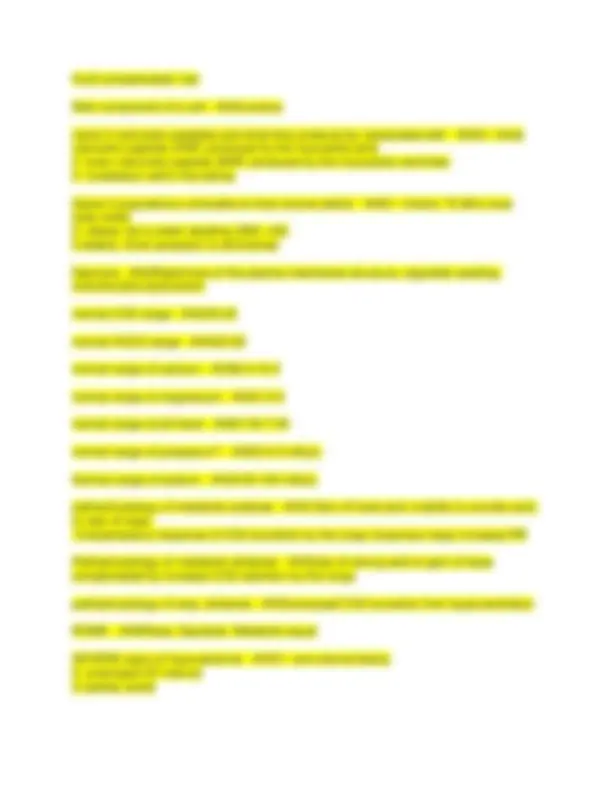
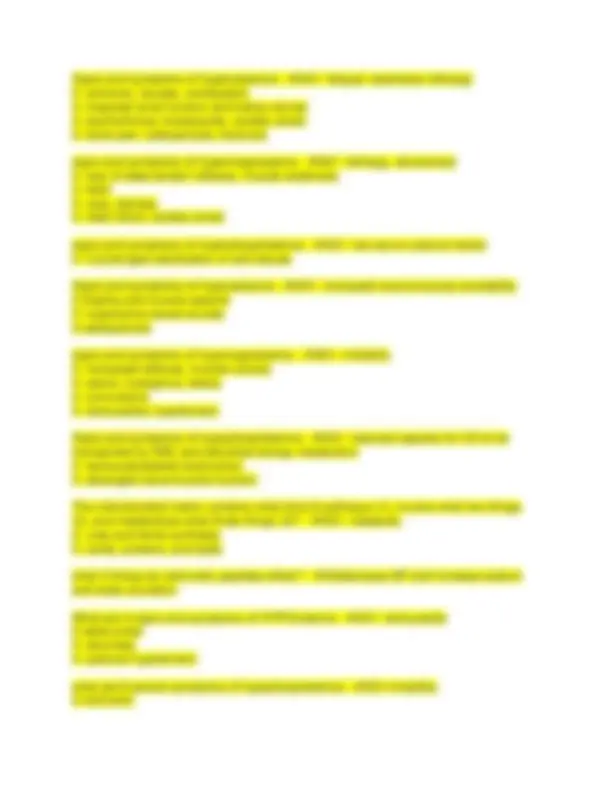
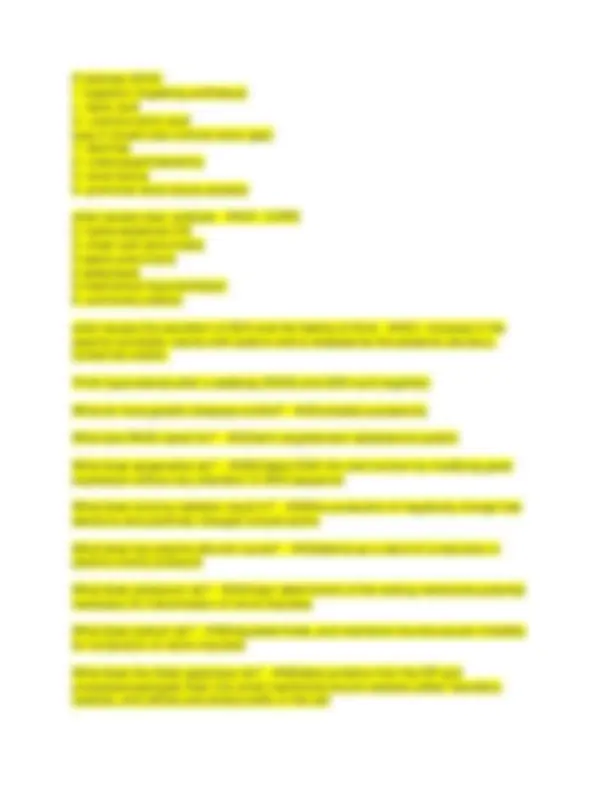
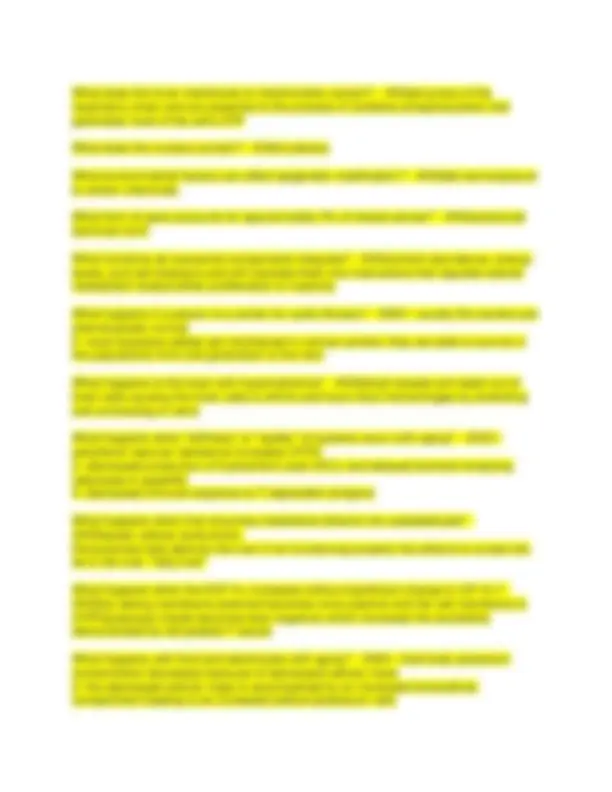
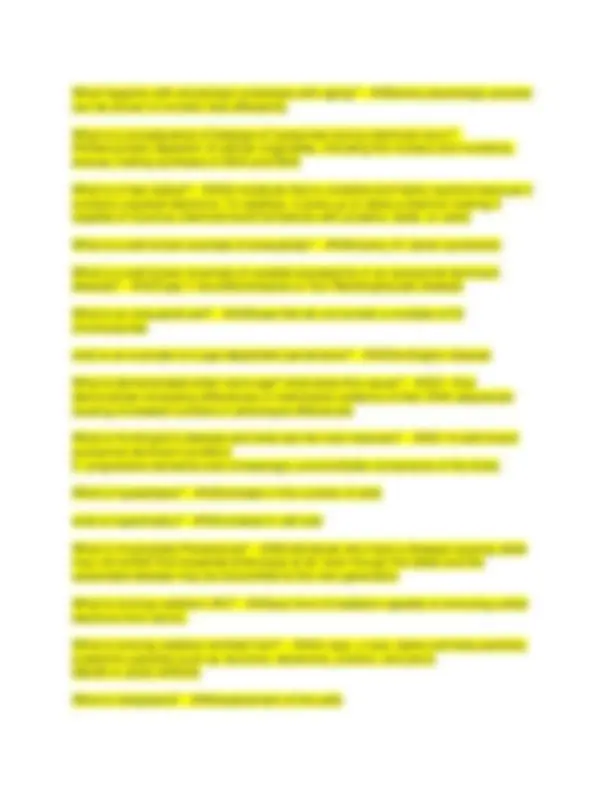



Study with the several resources on Docsity

Earn points by helping other students or get them with a premium plan


Prepare for your exams
Study with the several resources on Docsity

Earn points to download
Earn points by helping other students or get them with a premium plan
Community
Ask the community for help and clear up your study doubts
Discover the best universities in your country according to Docsity users
Free resources
Download our free guides on studying techniques, anxiety management strategies, and thesis advice from Docsity tutors
NURS 611 patho exam 1 & TEST BANK 2023-2024 COMPL
Typology: Exams
1 / 13

This page cannot be seen from the preview
Don't miss anything!








Apoptosis - ANSA programmed cell death that is regulated or programmed. Cellular self-destruction for elimination or unwanted cell populations Calcium and phosphorus have what kind of relationship> and is influenced by which 3 things? - ANS1- reciprocal 2 - PTH, calcitonin, and vit D causes of hypermagnesemia - ANS1- renal insufficiency or failure (most common) 2 - excessive intake of mag antacids 3 - adrenal insufficiency causes of hyperphosphatemia - ANS1- acute or chronic renal failure 2 - treatment of metastatic tumors with chemo that releases large amounts of phosphate 3 - long term use of laxatives/enemas 4 - hypoparathyroidism causes of hypocalcemia? - ANS1- Hypoalbuminemia 2 - massive blood administration 3 - Decreases in PTH and Vit D levels 4 - malnutrition 5 - alkalosis 6 - elevated calcitonin level 7 - pancreatitis 8 - inadequate GI absorption causes of hypomagnesemia - ANS1- malnutrition 2 - alcoholism 3 - malabsorption syndrome 4 - urinary losses Causes of metabolic alkalosis - ANS1- vomiting 2 - NG suctioning 3 - Hypokalemia 4 - diuretic therapy excess HCO3 intake causes of resp. alkalosis - ANS1- hyperventilation 2 - stroke, septicemia, meningitis, encephalitis, brain injury 3 - mechanical hyperventilation
cellular metabolism- what molecule gives us energy? - ANSATP functions as the energy-transferring molecule Cystic fibrosis is caused by what type of gene? - ANSautosomal recessive During ischemia, what effect does the loss of ATP have on the cells? - ANSa reduction of ATP levels (ATP needs oxygen) that causes the Na+/K+ pump and Na+/Ca exchange to fail, leading to intracellular accumulation of Sodium and calcium and diffusion of K+ out of the cell. Sodium and water can enter cell freely causing cellular swelling Example of beneficial physiologic hypertrophy? - ANShypertrophy of myocardial cells from endurance training example of compensatory hyperplasia? - ANSregeneration of the liver example of hormonal hyperplasia - ANSenlargement of the uterus during pregnancy example of metaplasia - ANSnormal columnar ciliated epithelial cells of the bronchial lining being replaced by squamous cells. can be reversed if irritant stopped example of pathologic hypertrophy - ANScardiomegaly in a hypertensive patient example of pathological hyperplasia - ANSendometrial tissue explain how fluid moves from the intravascular space into the interstitial space. what is it influenced by>? - ANSthrough the arterial end of capillaries and the capillary hydrostatic pressure being higher than the capillary oncotic pressure. It is influenced by the cardiac system (think about the heart getting fluids/nutrients where they need to go) Explain RAAS - ANS1- circulating blood volume/pressure is reduced felt by the kidneys 2 - renin is released in response to the sympathetic nerve stimulation and decreased perfusion of the renal vasculature. Angiotension I is converted into Angiotension II. 3 - aldosterone is pumped out by the adrenal glans (main hormone released to increase perfusion). aldosterone increased sodium and therefore an increase in storage of water and increases BP How common is a given disease in a population? - ANSwell-established measures are used to answer this question How does aging affect lysosomes? - ANSleads to progressive loss of lysosomal efficiency which declines the regenerative capacity of organs and tissue How does someone get cystic fibrosis? - ANSthe individual must be homozygous for a recessive allele to express the disease (both parents have to have the allele)
hco3 compensated- low Main component of a cell - ANSnucleus name 3 natriuretic peptides and what they produce by/ associated with - ANS1- Artial natriuetric peptide (ANP) produced by the myocardia atria 2 - brain natriuretic peptide (BNP) produced by the myocardia ventricles 3 - Urodilation within the kidney Name 3 populations vulnerable to fluid volume deficit - ANS1- infants: 75-80% total body water 2 - obese: fat is water repelling (BMI >30) 3 - elderly: thirst sensation is diminished Necrosis - ANSRapid loss of the plasma membrane structure, organelle swelling, mitochondria dysfunction normal CO2 range - ANS35- 45 normal HCO3 range - ANS22- 26 normal range of calcium - ANS8.5-10. normal range of magnesium - ANS1.5- 3 normal range of pH level - ANS7.35-7. normal range of potassium? - ANS3.5-5 mEq/L Normal range of sodium - ANS135-145 mEq/L pathophysiology of metabolic acidosis - ANS-Gain of fixed acid ,inability to excrete acid, or loss of base.
Signs and symptoms of hypercalcemia - ANS1- fatigue/ weakness/ lethargy 2 - anorexia, nausea, constipation 3 - impaired renal function and kidney stones 4 - dysrhythmias, bradycardia, cardiac arrest 5 - bone pain. osteoporosis, fractures signs and symptoms of hypermagnesemia - ANS1- lethargy, drowsiness 2 - loss of deep tendon reflexes, muscle weakness 3 - N&V 4 - resp. distress 5 - heart block, cardiac arrest signs and symptoms of hyperphosphatemia - ANS1- low serum calcium levels 2 - if prolonged-calcification of soft tissues Signs and symptoms of hypocalcemia - ANS1- increased neuromuscular excitability 2 - tingling and muscle spasms 3 - hyperactive bowel sounds 4 - osteoporosis signs and symptoms of hypomagnesemia - ANS1- irritability 2 - increased reflexes, muscle cramps 3 - ataxis, nystagmus, tetany 4 - convulsions 5 - tachycardia, hypotension Signs and symptoms of hypophosphatemia - ANS1- reduced capacity for O2 to be transported by RBC and disturbed energy metabolism 2 - leukocyte/platelet dysfunction 3 - deranged nerve/muscle function The mitochondrial matrix contains what kind of pathways (1), involve what two things (2), and metabolizes what three things (3)? - ANS1- metabolic 2 - urea and heme synthesis 3 - carbs, proteins, and lipids what 2 things do natriuretic peptides affect? - ANSdecrease BP and increase sodium and water excretion What are 4 signs and symptoms of HYPOvolemia - ANS1- tachycardia 2 - weak pulse 3 - dizziness 4 - postural hypotension what are 8 severe symptoms of hypophosphatemia - ANS1-irritability 2 - confusion
What are the clinical manifestations of severe hypernatremia (4 C's) - ANSconfusion, convulsion, cerebral hemorrhage, and coma What are the major characteristics of type 1 DM? - ANS1- T-cell infiltration of the pancreas 2 - destruction of the insulin-producing beta cells 3 - auto-antibodies are formed against pancreatic cells what are the signs and symptoms of hypokalemia? - ANS1- cardiac- flat t-waves, AV block, bradycardia 2 - paralytic ileus (N&V) What can accumulate intracellularly caused by stresses form metabolic dearangements? - ANScarbs, proteins, and lipids What can epigenetic modification cause individuals with the same DNA (twins) - ANShave different disease profiles Ex: the occurrence of asthma in only one pair of the identical twins what causes hypercalcemia - ANS1- hyperparathyroidism 2 - bone metastases 3 - sarcoidosis 4 - excess vit D 5 - tumors that produce PTH 6 - calcium containing antacids what causes hyperkalemia? - ANS1- renal failure 2 - addison's disease (due to decrease production of aldosterone causes body to hold onto K+) what causes hypernatremia? - ANS1- inadequate free water intake (elderly) 2 - inappropriate hypertonic solution (3% and 5% NS) 3 - over secretion of aldosterone what causes hyponatremia? - ANS1- sodium deficits (diuretics, vomiting, diarrhea) 2 - diseases (kidney, heart and liver failure) 3 - hypotonic solutions (D5W) what causes hypophosphatemia - ANS1- GI malabsorption r/t Vit D deficiency 2 - use of mag/aluminum antacids 3 - long term alcohol abuse 4 - respiratory alkalosis 5 - increased renal excretion of phosphate associated with hyperparathyroidism what causes metabolic acidosis, two types - ANStype 1: increased non-carbonic acids (elevated anion gap)
K-ketones (DKA) I- Ingestion (ingesting antifreeze) L- lactic acid U- uremia/uremic acid type 2: bicarb loss (normal anion gap) 1 - diarrhea 2 - ureterosigmoidostomy 3 - renal failure 4 - promimal renal tubule acidosis what causes resp. acidosis - ANS1- COPD 2 - barbs/sedatives OD 3 - chest wall abnormality 3 - seere pneumonia 4 - atelectasis 5 - mechanical hypoventilation 6 - pulmonary edema what causes the secretion of ADH and the feeling of thirst - ANS1- increase in the plasma osmolality (works with sodium and is released by the posterior pituitary), conserves waters. Think hypovolemia after a stabbing (RASS and ADH work together) What do most genetic diseases exhibit? - ANSvariable expressivity What doe RAAS stand for? - ANSrenin angiotension-aldosterone system What does epigenetics do? - ANSbridges DNA info and function by modifying gene expression without any alteration in DNA sequence What does ionizing radiation result in? - ANSthe production of negatively charge free elections and positively charged ionized atoms What does low plasma albumin cause? - ANSedema as a result of a reduction in plasma oncotic pressure What does potassium do? - ANSmajor determinant of the resting membrane potential necessary for transmission of nerve impulses What does sodium do? - ANSregulates fluids, and maintains neuromuscular irritability for conduction of nerve impulses What does the Golgi apparatus do? - ANStakes proteins from the ER and processes/packages them into small membrane-bound vesicles called "secretory vesicles, and refines and directs traffic in the cell
What happens with physiologic processes with aging? - ANSevery physiologic process can be shown to function less effeciently What is a consequence of leakage of lysosomes during chemical injury? - ANSenzymatic digestion of cellular organelles, including the nucleus and nucleolus, ensues, halting synthesis of DNA and RNA What is a free radical? - ANSA molecule that is unstable and highly reactive because it contains unpaired electrons. To stabilize, it gives up or takes a electron making it capable of injurious chemical bond formations with proteins, lipids, or carbs What is a well known example of aneuploidy? - ANStrisomy 21 (down syndrome) What is a well-known example of variable expressivity in an autosomal dominant disease? - ANSType 1 neurofibromatosis or Von Recklinghausen disease What is an aneuploid cell? - ANSthose that do not contain a multiple of 23 chromosomes what is an example of a age-dependent penetrance? - ANSHuntington disease What is demonstrated when twins age? what does this cause? - ANS1- they demonstrate increasing differences in methylation patterns of their DNA sequences causing increased numbers in phenotype differences What is Huntington's disease and what are the main features? - ANS1-A well-known autosomal dominant condition 2 - progressive dementia and increasingly uncontrollable movements of the limbs What is hyperplasia? - ANSincrease in the number of cells what is hypertrophy? - ANSincrease in cell size What is Imcomplete Penetrance? - ANSindividuals who have a disease-causing allele may not exhibit that expected phenotype at all, even though the allele and the associated disease may be transmitted to the next generation What is ionizing radiation (IR)? - ANSany form of radiation capable of removing orbital electrons from atoms. What is ionizing radiation emitted from? - ANSx-rays, y-rays, alpha and beta particles, subatomic particles such as neutrons, deuterons, protons, and pions WEAR A LEAD APRON What is metaplasia? - ANSreplacement of the cells
What is mitochondria responsible for? - ANScellular respiration, cellular metabolism , and energy production What is oncotic pressure heavily influenced by? - ANSplasma proteins What is oncotic pressure? - ANSaka colloidal osmotic pressure- it is pressure exerted by proteins, notably albumin, in the blood vessels plasma that tends to pull water into the circulatory system What is pathologic atrophy? - ANSoccurs as a result of decreases in workload, use, pressure, blood supply, nutrition, and hormonal stimulation. Ex: Shrinking of gonads in an adolescent pt in response to decreased hormonal stimulation. and an pt immobilized in bed for a prolonged time What is physiologic atrophy? - ANSoccurs in early development. ex: thymus glad during childhood What is renin? - ANSan enzyme secreted by the juxtaglomerular cells of the kidney that promotes the production of the protein angiotensin. What is sarcopenia? - ANSmuscular atrophy: degenerative skeletal muscle loss how fast it happens depends on nature/nurture What is the #1 cause of cellular injury leading to necrosis (especially the kidney and heart) - ANShypoxia What is the #1 cause of hypoxia? - ANSischemia What is the chance of a lifetime risk of developing breast cancer for women who inherit the BRACA1 or BRACA2 gene? - ANS50-80% what is the compensatory response of resp acidosis? - ANSincreased HCO3 retention by kidneys what is the compensatory response of resp. alkalosis? - ANSincreased HCO3 excretion by kidney What is the definition of Expressivity? - ANSthe extent of variation in the phenotype associated with a particular genotype What is the definition of incidence rate? - ANSnumber of new cases of a disease reported during a specific period (typically 1 year) divided by the number of individuals in the population
When messenger RNA (mRNA) is over-expressed what does it result in and why? - ANS1-results in metastasis of an already existing cancer 2 - hypermethylation is in miRNA genes that bind to the ends of mRNAs, degrading them and preventing their translation, so when mRNA targets are over-expressed it increases metastasis ability to continue. When should a person be investigated for hyperkalemia? - ANS1-hx of renal disease or failure 2 - massive trauma 3 - insulin deficiency 4 - addison's disease 5 - use of K+ salts or K+ rich foods 6 - metabolic acidosis Where can ribosomes be found? - ANScytoplasm and rough ER Which genes are responsible for this form of breast cancer? - ANSBRACA (chromosome 17) and BRACA2 (chromosome 13) Who does cystic fibrosis affect most? - ANSwhite children-most lethal autosomal recessive disease Why are histone important? - ANShistones bind to DNA and fold it into chromosomes (chromatin) which is essential for cell division Why do we see hyperkalemia and metabolic acidosis together? - ANShydrogen ions shift into the cells in exchange for ICF potassium